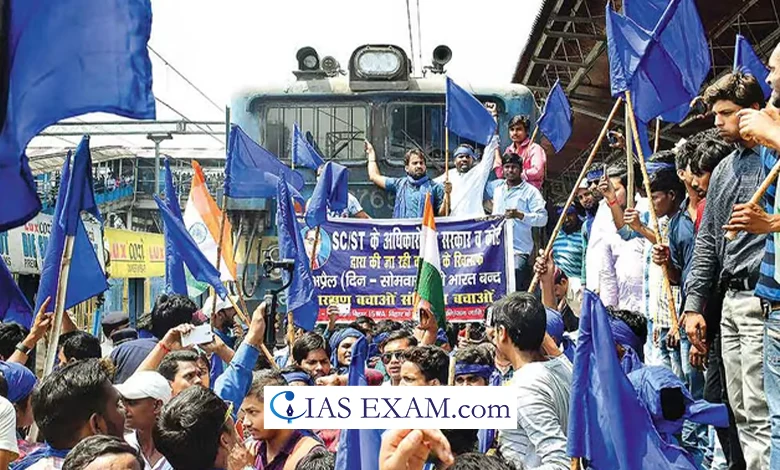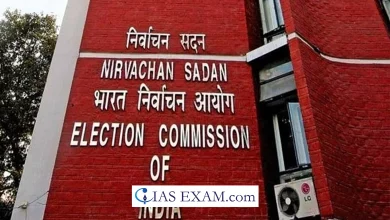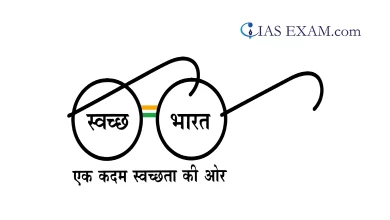Limitations of Ambedkarite Dalit Politics in India
GS Paper 2 - Laws, Institutions and bodies constituted for Vulnerables

Context
Organising grand events and celebrations in April to commemorate Babasaheb Ambedkar’s birth anniversary has become a national ritual now. Ambedkar envisioned the Dalit-Bahujan mass as the prime claimant of state power, aiming to form a greater social alliance with Adivasis, poor working classes, and agrarian laborers against exploitative orders.
Ambedkarite Dalit politics in India has played a significant role in advocating for the rights and empowerment of Dalits, inspired by the ideologies of Dr. B.R. Ambedkar. However, despite its noble intentions and efforts, this political movement faces various limitations and challenges that hinder its effectiveness in addressing the socio-economic and political issues faced by Dalits in India.
History of Dalit Movements in India
The history of Dalit movements in India is a testament to the relentless struggle for social justice, equality, and dignity waged by Dalit communities against centuries of caste-based oppression and discrimination.
Early Reform Movements
The origins of Dalit movements in India can be traced back to the 19th century with the emergence of social reformers such as Jyotirao Phule, Mahatma Jyotiba Phule, and Periyar E.V. Ramasamy. These pioneers of social reform challenged the caste system and advocated for the rights and dignity of Dalits through their writings, speeches, and activism. Their efforts laid the foundation for the Dalit movement in India by raising awareness about caste-based discrimination and oppression.
Dalit Panther Movement
The Dalit Panther movement, which emerged in Maharashtra in the 1970s, marked a significant turning point in the history of Dalit movements in India. Inspired by the Black Panther Party in the United States, the Dalit Panthers sought to combat caste-based discrimination and violence through militant activism and grassroots organizing. The movement galvanized Dalit youth and mobilized them to confront caste oppression head-on, challenging the status quo and demanding social justice and equality.
Ambedkarite Movement
The Ambedkarite movement, named after Dr. B.R. Ambedkar, the architect of the Indian Constitution and a champion of Dalit rights, has been a central force in Dalit politics and activism. Drawing inspiration from Ambedkar’s teachings and vision, the movement advocates for the annihilation of caste and the empowerment of Dalits through education, political mobilization, and social reform. The movement has spearheaded campaigns for the implementation of affirmative action policies, land reforms, and access to education and employment opportunities for Dalits.
Contemporary Dalit Movements
In contemporary India, Dalit movements continue to evolve and adapt to the changing social and political landscape. Organizations such as the Bahujan Samaj Party (BSP), Dalit Shoshan Mukti Manch (DSMM), and National Campaign on Dalit Human Rights (NCDHR) are at the forefront of the struggle for Dalit rights and empowerment. These movements leverage various strategies, including legal advocacy, grassroots mobilization, and political representation, to address issues such as caste-based violence, discrimination, and socio-economic marginalization.
Challenges faced by Dalit Movements
- Fragmentation in Dalit Political Legacy: Despite the solidarity exhibited at commemorations, Ambedkar’s political legacies are splintering, with Dalit political parties becoming quiet and marginalized powers.
- Disintegration of Contemporary Ambedkarite Dalit Politics: Dalit politics now lacks visionary leadership, a solid social base, and effective political methods to emerge as a key actor in democratic conflicts. It has fragmented into parts.
- Political coalitions and Vacillations: Despite the fact that Ambedkar’s beliefs are essentially opposed to Brahmanical and exploitative systems, Dalit groups have made coalitions with organizations such as the BJP. This has resulted in criticism and allegations of losing key values.
- Issue in Representation – The challenge of Representation is also one of the primary reasons. While this political movement aims to uplift and empower Dalits, it often struggles to adequately represent the diverse interests and aspirations of the Dalit community. The dominance of certain leaders or political parties within the movement can result in the marginalization of alternative voices and perspectives, thereby limiting the inclusivity of Dalit political discourse.
- Inadequate Socio-Economic Empowerment – Ambedkarite Dalit politics aims to empower and improve Dalits, but often falls short in practice. Despite constitutional protections and affirmative action programs, Dalits continue to experience systematic discrimination and exclusion from mainstream society. Limited access to education, work prospects, and basic necessities perpetuates the cycle of poverty and marginalization among Dalit communities.
- Political Instrumentalization – Mainstream political parties may use Ambedkarite Dalit politics for their own purposes. While these parties may give lip service to Dalit emancipation, their actions frequently emphasize political gains above actual efforts to solve Dalit concerns. As a result, Dalit issues are frequently ignored or co-opted for political gain, jeopardizing the Dalit political movement’s autonomy and efficacy.
Measures and Way Forward
- Building Stronger Intra-Dalit togetherness: Encourage conversation and collaboration among various Dalit political groupings to foster a feeling of togetherness and shared purpose.
- Investing in Leadership Development: Encourage efforts that foster visionary leadership within the Dalit community.
- Strengthening Grassroots Mobilization: Work to develop a solid social basis by actively interacting with Dalit communities at the grassroots level.
Conclusion
While Ambedkarite Dalit politics has made significant progress in promoting awareness of Dalit rights and empowerment, it is vital to recognize and overcome its constraints. Overcoming challenges such as inadequate representation, caste-based fragmentation, socioeconomic empowerment, and political instrumentalization is critical to fulfilling the Dalit political movement’s full potential in India. By overcoming these constraints and forming partnerships with like-minded forces, Ambedkarite Dalit politics may become a more powerful force for social justice and equality in the country.
SOURCE: The Hindu





.png)



